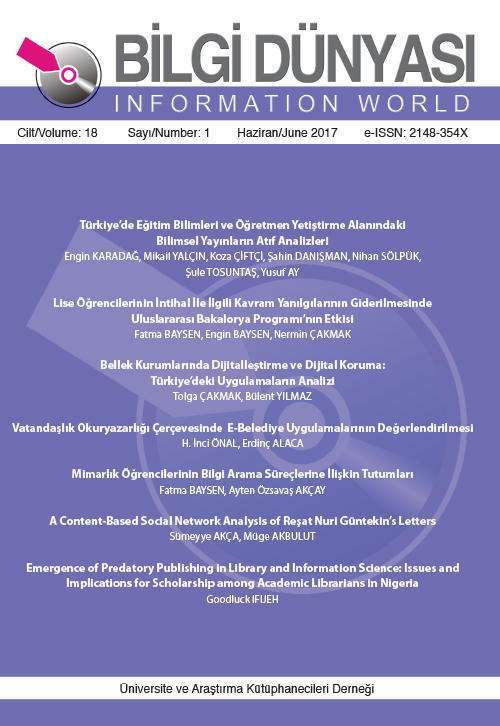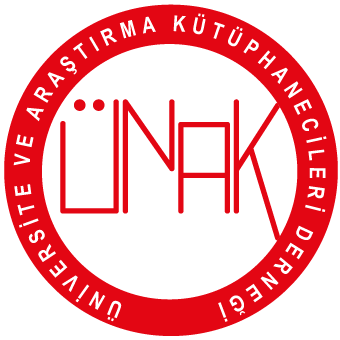Architecture Students Attitudes Toward Information Search Process
DOI:
https://doi.org/10.15612/BD.2017.596Keywords:
Information search process, attitude, architecture, undergraduate studentsAbstract
The aim of the study is to reveal architecture students’ attitudes toward Information Search Process (ISP). The sample is constituted by Turkish undergraduate students of department of architecture at faculty of architecture (n= 291) at Near East University. To reveal the attitudes toward ISP an attitude test of ISP, Attitude Scale for ISP (ASISP), was utilized. Data analyzed through frequencies, percentages, and Kolmogorov-Smirnov, Mann- Whitney U, and Kruskal- Wallis tests. Analyses showed that, change in independent variables grade and age do not make significant change at attitudes toward ISP. Girls were found to have significantly more positive attitudes toward ISP than boys. Those students who already took courses regarding ISP or information access have more positive attitude mean than those who did not, but the difference is not significant. The most remarkable finding for the present study is, the architecture students’ attitude level toward ISP is “intermediate”. This finding showed that the architecture students have not distinctive attitudes to carry efficient, fruitful, and successful ISP. Thus, it is important to give support to architecture students by courses of ISP, research methods, information retrieval, and scientific writing.
Downloads
References
Ajzen, I. (1989). Attitude structure and behavior. A. R. Pratkanis, A. J. Breckler and A. G. Greenwald (Ed.), Attitude structure and function içinde (s. 241-274). Hillsdale, New Jersey: Lawrence Erlbaum Associates.
Ajzen, I. (2005). Attitudes, personality and behavior (2. bs.). Maidenhead, England; New York: Open University Press.
Allport, G. W. (1967). Attitudes. M. Fishbein (Ed.), Readings in attitude theory and measurement içinde (s. 1-13). New York, London, Sydney: John Wiley & Sons.
Baysal, A. C. (1981). Sosyal ve örgütsel psikolojide tutumlar. İstanbul: İ. Ü. İşletme Fakültesi.
Baysen, F., Çakmak, N. ve Baysen, E. (2017). Bilgi okuryazarlığı ve öğretmen yetiştirme. Türk Kütüphaneciliği, 31(1), 55-89. http://tk.org.tr/index.php/TK/article/view/2760/2713 adresinden erişildi.
Burdick, T. A. (1995). Gender in the information search process: An exploratory study of student experience (Doktora tezi). ProQuest Dissertations and Theses Global veri tabanından erişildi. (UMI No. 304206534)
Büyüköztürk, Ş. (1999). Araştırmaya yönelik kaygı ile cinsiyet, araştırma deneyimi ve araştırma başarısı arasındaki ilişki. Eğitim ve Bilim, 23(1), 29-34. http://egitimvebilim.ted.org.tr/index.php/EB/article/view/5328 adresinden erişildi.
Challener, J. (1999). Information-seeking behavior of professors of art history and studio art (Yüksek lisans, Kent State Üniversitesi, Ohio). http://files.eric.ed.gov/fulltext/ED435405.pdf adresinden erişildi.
Cheng, Y. (2004). Thoughts, feelings, and actions: Quantitative comparisons of interactions and relationships among three factors in college students’ information seeking (Doktora tezi). ProQuest Dissertations and Theses Global veri tabanından erişildi. (UMI No. 3156319)
Creswell, J. W. (2003). Research design: Qualitative, quantitativ, and mixed methods approaches (2. bs.) Thousand Oaks: Sage Publications.
Çakmak, N. (2016). Lisans öğrencilerinin bilgi arama süreçleri ile ilgili kavramları, tutumları ve düşünceleri (Yayımlanmamış doktora tezi). Ankara Üniversitesi, Ankara.
Çakmak, N. ve Baysen, E. (2013). Kavram haritalarının bilgi arama süreçlerinde kullanılması. Bilgi Dünyası, 14(2), 358-372. http://bd.org.tr/index.php/bd/article/view/404/431 adresinden erişildi.
Deniz, K. Z. ve Çıtak, G. G. (2010). The investigation of factors affecting university students’ attitudes towards participation in scientific research. Procedia-Social and Behavioral Sciences, 2, 5183-5189. doi: 10.1016/j.sbspro.2010.03.843
Fainburg, L. I. (2009). Information seeking and learning: A comparison of Kuhlthau’s information seeking model and John Dewey’s problem solving model. New Library World, 110 (9-10), 457-466. doi: 10.1108/03074800910997472
Franzoi, S. L. (2006). Social psychology. (4. bs.). New York: McGraw-Hill.
George, C., Bright, A., Hurlbert, T., Linke, E. C., St. Clair, G. ve Stein, J. (2006) Scholarly use of information: graduate students’ information seeking behaviour. Information Research, 11(4). http://InformationR.net/ir/11-4/paper272.html adresinden erişildi.
Gonyea, N. E. (2013). Development, validity, and reliability of the preservice teachers’ attitude toward educational research (P-TATER) scale. The Journal of Research in Education, 23(2), 79-96. http://files.eric.ed.gov/fulltext/EJ1098424.pdf adresinden erişildi.
Hemmig, W. S. (2008). The information‐seeking behavior of visual artists: a literature review. Journal of Documentation, 64(3), 343-362. doi: 10.1108/00220410810867579
Hasol, D. (2002). Nasıl bir gelecek? Nasıl bir mimarlık? Mimarlık ve eğitim kurultayı: Nasıl bir gelecek nasıl bir mimarlık içinde (s. 42-44). Ankara: TMMOB Mimarlar Odası Genel Merkezi ve İstanbul Büyükkent Şubesi.
Hyldegård, J. (2006). Collaborative information behavior exploring Kuhlthau’s information search process model in a group-based educational setting. Information Processing and Management, 42(1), 276-298. doi: http://dx.doi.org/10.1016/j.ipm.2004.06.013
Isbell, D. ve Kammerlocher, L. (1998). Implementing Kuhlthau: A new model for library and reference instruction. Reference Services Review, 26(3-4), 33-44. doi: http://dx.doi.org/10.1108/00907329810307722
İlhan, A, Çelik, H. C. ve Aslan, A. (2016). Üniversite öğrencilerinin bilimsel araştırmaya yönelik tutumlarının incelenmesi. İnönü Üniversitesi Eğitim Fakültesi Dergisi, 17(2), 141-156. doi: 10.17679/iuefd.17218132
Kağıtçıbaşı, Ç. (2012). Günümüzde insan ve insanlar: Sosyal psikolojiye giriş (13. bs.). İstanbul: Evrim.
Konokman, G. Y., Tanrıseven, I., ve Karasolak, K. (2013). Öğretmen adaylarının eğitim araştırmalarına ilişkin tutumlarının çeşitli değişkenlere göre incelenmesi. Ahi Evran Üniversitesi Kırşehir Eğitim Fakültesi Dergisi (KEFAD), 14(1), 141-158. http://dergipark.gov.tr/download/article-file/15864 adresinden erişildi.
Korkmaz, Ö., Şahin, A. ve Yeşil, R. (2011). Bilimsel araştırmaya yönelik tutum ölçeği geçerlilik ve güvenirlik çalışması İlköğretim Online, 10(3), 961-973. http://toad.edam.com.tr/sites/default/files/pdf/bilimsel-arastirmaya-yonelik-tutum-olcegi-toad.pdf adresinden erişildi.
Kracker, J. (2002). Research anxiety and students’ perceptions of reseacrh: an experiment. Part 1. Effect of teaching Kuhlthau’s ISP model. Journal of American Society for Information Science and Technology, 53(4), 282-294. http://eds.b.ebscohost.com/eds/pdfviewer/pdfviewer?vid=2&sid=c4aa2a15-5a70-4a2f-b7f8-9d75a2a94372%40sessionmgr103&hid=112 adresinden erişildi.
Kuhlthau, C. C. (1983). The library research process: Case studies and interventions with high school seniors in advanced placement English classes using Kelly’s theory of constructs (Doktora tezi). ProQuest Dissertations and Theses Global veri tabanından erişildi. (UMI No. 303281567)
Kuhlthau, C. C. (1991). Inside the search process: information seeking from the user’s perspective. Journal of the American Society for Information Science, 42(5), 361-371. http://eds.b.ebscohost.com/eds/pdfviewer/pdfviewer?vid=2&sid=34902900-dd89-4319-bb9d-322090c8baca%40sessionmgr104&hid=112 adresinden erişildi.
Kuhlthau, C. C. (1996). Seeking meaning: A process approach to libray and information services (4. bs.). Norwood, NJ: Ablex.
Küçükahmet, L. (1987). Öğrencilerin çalışma alışkanlıkları ve tutumları: Üniversite öğrencileri üzerinde bir araştırma. Ankara: Ankara Üniversitesi Eğitim Bilimleri Yayınları.
Limberg, L. (1997). Information use for learning purposes. P. Vakkari., R. Savolainen ve B. Dervin. (Yay. Haz.), Information seeking in context, 14-16 Agust 1996 içinde (s. 275-289). United Kingdom: Taylor Graham.
Makri, S. ve Warwick, C. (2010). Information for inspiration: Understanding architects’ information seeking and use behaviors to inform design. Journal of The American Society for Information Science and Technology, 61(9), 1745-1770. doi: 10.1002/asi.21338
Matusiak, K. K. (2006). Information seeking behaviour in digital image collections: A cognitive approach. The Journal of Academic Librarianship, 32(5), 479-488. http://www.sciencedirect.com/science/article/pii/S0099133306000942?via%3Dihub adresinden erişildi.
Milburn, L-A. S. (1999). “...Research on research”: The application of attitude theory to research attitudes and behaviours of educators in landscape architecture (Yüksek lisans tezi). ProQuest Dissertations and Theses Global veri tabanından erişildi. (UMI No. MQ43191)
Önel, H. ve Ciravoğlu, A. (2002). Kurultayın teması ve genel mesaj. Mimarlık ve eğitim kurultayı: Nasıl bir gelecek-nasıl bir mimarlık içinde (s. 23-42). Ankara: TMMOB Mimarlar Odası Genel Merkezi ve İstanbul Büyükkent Şubesi.
Öztürk, M. A. (2011). Confirmatory factor analysis of the educators’ attitudes toward educational research scale. Educational Sciences: Theory and Practice, 11(2), 737-747. http://files.eric.ed.gov/fulltext/EJ927375.pdf adresinden erişildi.
Papanastasiou, E. C. (2005). Factor structure of the ‘attitudes towards research’ scale. Statistics Education Research Journal, 4(1), 16-26. http://s3.amazonaws.com/academia.edu.documents/5977271/10.1.1.154.4738.pdf?AWSAccessKeyId=AKIAIWOWYYGZ2Y53UL3A&Expires=1490435840&Signature=lQ0peXC6EYiC8fSTl%2BpdtPgMTEw%3D&response-content-disposition=inline%3B%20filename%3DA_FRAMEWORK_FOR_TEACHING_AND_ASSESSMENT_R.pdf adresinden erişildi.
Peterson, J. W. (2008). Networked generation youth’s information seeking process: An examination of cognitive, affective, and physical information seeking behaviors and problem solving techniques (Doktora tezi). ProQuest Dissertations and Theses Global veri tabanından erişildi. (UMI No. 304538787)
Pinto, M. ve Sales, D. (2015). Uncovering information literacy’s disciplinary differences through students’ attitudes: An empirical study. Journal of Librarianship and Information Science, 47(3), 204-215. doi: 10.1177/0961000614532675
Rosenberg, M. J. ve Hovland, C. I. (1966). Cognitive, affective, and behavioral components of attitudes (3. bs.). M. J. Rosenberg, C. I. Hovland, W. J. McGuire, R. P. Abelson and J. W. Brehm (Yay. Haz.), Attitude organization and change: An analysis of consistency among attitude components içinde (s. 1-14). New Haven and London: Yale University.
Rouse, W. B ve Rouse, S. H. (1984). Human information seeking and design of information systems. Information Processing and Management, 20(1-2), 129-138. doi: 10.1016/0306-4573(84)90044-X
Saracaloğlu, A. S. (2008). Lisansüstü öğrencilerin akademik güdülenme düzeyleri, araştırma kaygıları ve tutumları ile araştırma yeterlikleri arasındaki ilişki. Yüzüncü Yıl Üniversitesi, Eğitim Fakültesi Dergisi, 5(2), 179-208 http://dergipark.ulakbim.gov.tr/yyuefd/article/viewFile/5000055601/5000052905 adresinden erişildi.
Saracaloğlu, A. S., Varol, S. R. ve Ercan, İ. E. (2005). Lisansüstü eğitim öğrencilerinin bilimsel araştırma kaygıları, araştırma ve istatistiğe yönelik tutumları ile araştırma yetenekleri arasındaki ilişki. Buca Eğitim Fakültesi Dergisi, 17, 187-199. http://www.befjournal.com/index.php/dergi/article/viewArticle/68 adresinden erişildi.
Senemoğlu, N. (2013). Gelişim öğrenme ve öğretim: Kuramdan uygulamaya (23. bs.). Ankara: Yargı Yayınevi.
Schwarz, N. (2008). Attitude measurement. W. D. Crano ve R. Prislin (Yay. Haz.), Attitudes and attitude change içinde (s. 41-60). New York: Taylor & Francis.
Taşdemir, M. ve Taşdemir, A. (2011). Öğretmen adaylarının bilimsel araştırmaları inceleme yeterlikleri. Selçuk Üniversitesi Sosyal Bilimler Enstitüsü Dergisi, 26, 344-353. http://dergisosyalbil.selcuk.edu.tr/susbed/article/view/173 adresinden erişildi.
Tavşancıl, E. (2010). Tutumların ölçülmesi ve SPSS ile veri analizi (4. bs.). Ankara: Nobel.
Teymur, N. (1997). Bir mimarlık eğitimi kuramına doğru: Mimarlık eğitiminin bugünü için bir genel çerçeve önerisi. Y. Al ve N. Teymur (Derleyenler), Mimarlık eğitimi ve…içinde (s. 5-43). Ankara: TMMOB Mimarlar Odası Ankara Şubesi.
Türkiye’de mimarlık 2011. (2011). B. Tuna (Ed.), D. A. Canatay, N. M. Cengizkan ve Y. E. Gültekin (Yay. Haz.). Ankara: TMMOB Mimarlar Odası.
Uzman, B. ve Baysen, E. (2012). Öğretmen adaylarının eğitim programlarına ilişkin tutum ve düşünceleri. Hacettepe Üniversitesi Eğitim Fakültesi Dergisi, Özel Sayı 2, 200-211. http://www.efdergi.hacettepe.edu.tr/yonetim/icerik/makaleler/649-published.pdf adresinden erişildi.
Ünal, C. (1981). Genel tutumların veya değerlerin psikolojisi üzerine bir araştırma. Ankara: Ankara Üniversitesi Dil ve Tarih-Coğrafya Fakültesi Yayınları.
Yaşar, M. (2014). Bilimsel araştırma yöntemleri dersine yönelik tutum ölçeği geliştirme çalışması: Geçerlik ve güvenirlik. Eğitim Bilimleri Araştırmaları Dergisi, 4(2), 109-129. http://s3.amazonaws.com/academia.edu.documents/40168884/Bilimsel_Arastirma_Yontemleri.pdf?AWSAccessKeyId=AKIAIWOWYYGZ2Y53UL3A&Expires=1498317171&Signature=CEYUGNPeDN1Obp5%2F5iIwCM6jnn8%3D&response-content-disposition=inline%3B%20filename%3DBilimsel_Arastirma_Yontemleri_Dersine_Yo.pdf adresinden erişildi.
Zencir, M. B. (2007). Güzel sanatlar alanındaki kullanıcıların bilgi gereksinimleri ve bilgi kullanım özellikleri: Hacettepe Üniversitesi örneği (Yüksek lisans tezi). https://tez.yok.gov.tr/UlusalTezMerkezi/tezSorguSonucYeni.jsp adresinden erişildi.
Published
How to Cite
Issue
Section

This work is licensed under a Creative Commons Attribution 4.0 International License.






